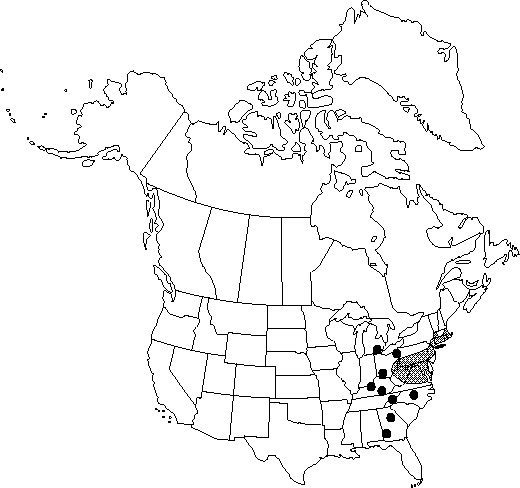Akebia quinata
Arch. Mus. Hist. Nat. 1: 195, fig. 1(a-c). 1839.
Plants, deciduous to semievergreen, climbing to 12 m, glabrous. Leaves: petiole 1.6-12.5 cm; leaflets mostly 5, petiolules 0.2-2.2 cm, blades oblong to ovate-elliptic, 0.7-8.2 × 0.4-4.2 cm, base rounded, margins entire, apex retuse. Inflorescences pendent, 4.5-12 cm; pedicel with basal bracts. Flowers fragrant. Staminate flowers 4-15 per inflorescence, 1.2-1.6 cm diam.; sepals oblong to ovate or elliptic, 5-9 mm; stamens 4-5 mm. Pistillate flowers (0-) 1-5 per inflorescence, 2-3 cm diam.; sepals elliptic to ovate or nearly orbiculate, 10 16mm; pistils 3-7, 1 or more maturing. Follicles glaucous, violet to dark purple, oblong, 5-15 cm. Seeds black, ovoid, embedded in whitish pulp.
Phenology: Flowering spring, fruiting fall (Sep–Oct).
Habitat: Waste places, open woodlands
Elevation: 0-400 m
Distribution

Introduced; Conn., Ga., Ind., Ky., Md., Mass., Mich., N.J., N.Y., N.C., Ohio, Pa., Va., W.Va., native, Asia
Discussion
No specimens are known from Rhode Island.
A fast-growing, invasive vine whose aggressiveness may at times approach that of Lonicera japonica, Akebia quinata is occasionally planted as an ornamental; it is of more botanical than horticultural interest. A greenish to whitish flowered variant, known from Asia, is cultivated in North America. The edible, though allegedly insipid, fruits are apparently uncommon in cultivation; cross pollination appears to be necessary for their development (C. S. Sargent 1891).
Selected References
None.
